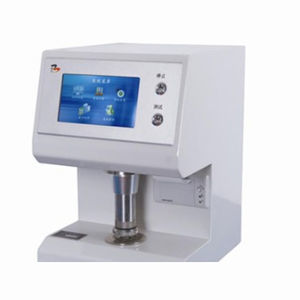

- Company
- Products
- Catalogs
- News & Trends
- Exhibitions
Bending testing system LTTD-10Sstiffnesspaper and cardboardindustrial

Add to favorites
Compare this product
Characteristics
- Test type
- bending, stiffness
- Tested product
- paper and cardboard
- Applications
- industrial, laboratory
- Other characteristics
- automatic, PC-controllable
Description
Microcomputer Bending Stiffness Tester LTTD-10S
The bending stiffness tester is used to test the bending stiffness of paper and paperboard. The bending stiffness can be used to test the bending stiffness performance of sheet materials such as film, mica sheet, graphite sheet and composite material.
• Sample size : 38*70mm(Standard size)
• Actual measurement size : 38*50mm(standard)
• Span range : span length 1~60mm,5mm、10mm、15mm、20mm、25mm、30mm、40mm、50mm,8 Adjustable 8-gear lever
• Span accuracy : ±0.1mm test range:(0~10000)mN
• Sensing accuracy : ±0.1%
• Resolution : 0.01mN
• Bending angle : 1~92 º stepless
• Angle measurement: : a single angle is measured each time, and there is stepless range of 0 ~ 90 °
• Angular velocity control : 0.5 – 50 °/sec adjustable
• Measuring thickness : 0.01~5.0 mm Paper grade and other composite materials
• Power : 220V 50Hz
Bending time: select different bending time according to the elasticity of the material
Sample fixture: manual fixture operation, automatic reset after test Operation interface: 7inch touch screen operation interface, visual menu operation.
Clamping mode: unlimited clamping, non-destructive and continuous clamping
Signal output: standard computer signal output, link computer, IMT computer operating platform, can realize document editing(optional)
Self calibration: the equipment can realize self calibration, with calibration tools as standard
Printing output: modular integrated thermal printer
Catalogs
No catalogs are available for this product.
See all of linktesting‘s catalogsRelated Searches
- Test machine
- Material testing machine
- Automatic test machine
- PC-controllable testing machine
- Vertical test machine
- Industrial test machine
- Digital testing system
- Industrial testing system
- Laboratory test machine
- Precision test machine
- Automatic testing system
- Plastic test machine
- Resistance test machine
- Digital test machine
- Packaging test machine
- Tester with LCD screen
- USB testing system
- Resistance testing system
- Benchtop testing system
- Tensile strength test machine
*Prices are pre-tax. They exclude delivery charges and customs duties and do not include additional charges for installation or activation options. Prices are indicative only and may vary by country, with changes to the cost of raw materials and exchange rates.





